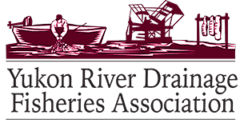Background: In-season salmon management teleconferences are held Tuesdays in June, July, and August for fishing villages and managers in the Yukon River drainage to discuss fishing conditions and management strategies as the salmon run is occurring. The teleconferences are funded by the Office of Subsistence Management and the Yukon River Panel.
Villages Reporting: Hooper Bay, Alakanuk, Emmonak, Pilot Station, Russian Mission, Nulato, Huslia, Galena, Nenana, Fort Yukon, Eagle.
Call summary: The call opened with village identification and reports on fishing and river conditions starting at the coast of the Yukon River mouth in Hooper Bay which reported people catching kings and chums this past week. Alakanuk reported that people have been catching some nice bright chums and maybe some kings too. People are just getting started in Emmonak with chums and there is not too much debris and it is warming up. From Pilot Station on up the river there were reports of higher water that is dropping in some places and little to high levels of driftwood in the river. People reported fishing for sheefish, whitefish and pike.
Management discussion:
The Alaska Department of Fish and Game (ADF&G) reviewed why they were using 6 inch mesh nets as opposed to the 7.5 mesh nets that were supplied to the public in response to a reduction in mesh size from the Alaska State Board of Fisheries in 2011. The 7.5-inch mesh size gillnets are intended to target Chinook salmon, while allowing the larger and older females through to the spawning grounds. However, 7.5-inch mesh size gillnets still catch a lot of Chinook salmon overall. The 6-inch restriction is intended to minimize the overall harvest of Chinook salmon while allowing for harvest opportunity of smaller Chinook and summer chum salmon. Most management efforts during the summer season are being taken to conserve Chinook salmon while trying to allow for the harvest of other species like summer chum salmon. ADF&G also discussed the importance of filling in the subsistence catch calendars that are mailed to fishing households and asked people to record their harvests; sending back their calendars will enter them into a cash prize raffle.
ADF&G reviewed their preseason outlook, the status of test fisheries, their assessment and strategy to date. The Department of Fisheries and Oceans (DFO) Canada said they will be going into the season with a conservative approach. If the fish come in at the low end of the range, they are prepared to harvest only 25% of their usual harvests and some First Nations have taken this further to voluntarily limit all harvests of Chinook salmon due to the low returns.
Public comments, questions, and answers:
People talked about the way the fishery would be managed and there was a discussion related to ensuring that fairness in fishing closures takes place all along the river. It was asked if there would be fish for the Elders and ADF&G mentioned the opportunity to fish for king salmon before and after the pulse closures; there will be limited opportunity to access king salmon.
Closures on the Tanana River were discussed and some Tanana representatives mentioned that their Chinook stocks do not go to Canada, but that the Chena River numbers have been low and there is the need to protect those stocks as well through management and possibly additional research projects. Tanana folks commended the Canadians for their conservation efforts.
It was asked if anybody was going to replace the newly distributed 7.5 inch nets with 6 inch nets and Tanana Chiefs Conference responded that they tried last year for disaster funds, but they did not become available; they recognize the hardship but there are not funds to buy new nets right now to distribute to people on the river
It was brought up that meaningful input should be accommodated on the teleconferences from local people and USFWS responded by agreeing with this and that if there is not adequate time on the calls people can get in touch directly with them.
Salmon bycatch was raised again as an important issue to address. We are taking all comments and preparing for a call in July to specifically address the topic of salmon bycatch.
Additional Information:
For information on the Alaskan fishing schedule, call the toll-free number of 1-866-479-7387.
For news releases, fishery announcements and updates from the Alaska Department of Fish Game, click here to visit their website.
For further information about these teleconferences, please contact the Yukon River Drainage Fisheries Association at 907-272-3141, extension 102 for Jill Klein or look for us on the web at www.yukonsalmon.org.
All teleconferences are scheduled for Tuesday at 1 p.m. Alaska time (2 p.m. Yukon time) during June, July and August. The toll free number is 1-800-315-6338 and the code is 98566#.
